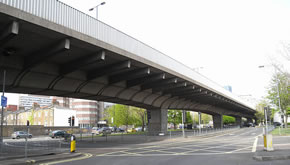Hammersmith Flyover Closed Overnight from Thursday
Complete shutdown between midnight and 5am for at least four days
Transport for London has announced that Hammersmith Flyover will close overnight for four consecutive nights from tonight, Thursday, March 8, while engineers carry out repair works on the structure.
Hammersmith and Fulham Council says TfL has confirmed that the concrete bridge, which is the main route into and out of central London from the west and M4 and takes 90,000 vehicles every day, will be closed completely in both directions from midnight until 5am the following morning, from Thursday through to the morning of Monday March 12.
There is also the possibility that the flyover will be closed on Monday night from midnight until 5am on Tuesday (March 13), although TfL are yet to confirm this.
TfL has also advised that it will provide variable message signs (VMS) on the A4, at either end of the flyover, and diversions will be put in place. There will also be advance warning signs on roads approaching the flyover.
Deputy leader of Hammersmith & Fulham Council, Cllr Nick Botterill, said: “We have been pushing TfL to finish the repair works as soon as possible, ever since the flyover first closed at Christmas time, and to reopen it in full.
“Progress needs to speed up, so that residents and motorists in H&F are not delayed any longer than they need be. "
He adds: " We also need to plan in earnest for the future with a longer-term alternative to the flyover rather than just patching up this crumbling, decaying structure."
This news follows another announcement made this week by Tfl assuring the public the flyover is on track to be fully reopened well before the start of the Olympic Games - although no specific date has been given for full reopening.
They say that the repairs will ensure the flyover remains in use for many decades countering fears that the structure would need to be totally rebuilt after the Olympics.
The first new tensioning cables are to be installed during coming months with diamond cutting being used to remove the existing concrete.
Work to strengthen the five weakest spans of the 16 span structure will be completed ahead of the 2012 Games, ensuring that the flyover can carry full traffic loading during the Games. Afterwards, TfL will return to the structure to strengthen the remaining spans. This work however will not require further weight restrictions to be imposed and TfL hope to complete it with only off peak lane closures, causing much less disruption than is presently the case.
The works, which began in January, have seen around 200m of the central reservation along the flyover removed in preparation for new cables which will support the structure. Using a number of specialist techniques including hydrodemolition and diamond cutting, around 140 tonnes of concrete have been removed by using both high pressurised water and a rotating cord impregnated with diamonds to cut the material away. These techniques meant that work could be carried out safely while traffic continued to use the flyover.
TfL say that a team of engineers are working 24 hours a day, seven days a week to complete the work, often in a crawl space far less than human height. Now the key enabling works have been completed, they will begin to install a new concrete base, drainage and tailored anchorages for the new cables within the structure. The design for the new post-tensioning system will see new cables installed above and below the bridge deck inside a specially made duct, which will supplement the load capacity of the remaining cables.
The new ducts will then be filled with a wax oil to prevent deterioration from any water ingress, as well as enable the cables to be easily replaced as and when required.
Isabel Dedring, Deputy Mayor for Transport, said: “Our team are well aware of the major impact these works have in west London for road users and local people. That is why the engineers are working twenty four hours a day to get the job done. They are making good progress but while the restrictions are in place we will continue to have dedicated staff monitoring and managing the impact on traffic every hour of the day.”
March 8, 2012
